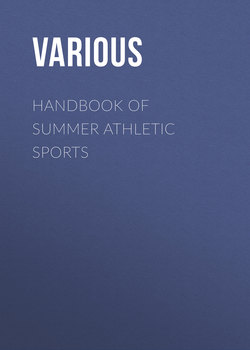Handbook of Summer Athletic Sports

Реклама. ООО «ЛитРес», ИНН: 7719571260.
Оглавление
Various. Handbook of Summer Athletic Sports
PEDESTRIANISM
WALKERS vs. RUNNERS
SCIENTIFIC WALKING
SCIENTIFIC RUNNING
DRESS FOR PEDESTRIANS
TRAINING FOR A MATCH
LAYING OUT A TRACK
CONDUCTING A MATCH
RECORDS OF PEDESTRIANISM
JUMPING AND POLE-LEAPING
BICYCLING
American Athletic Rules
English Athletic Rules
HARE AND HOUNDS
ARCHERY
Отрывок из книги
The success of Weston and O'Leary in their long-distance walks in England surprised the Britons greatly. Up to the time of Weston's appearance in that country, Englishmen had been accustomed to consider themselves the best walkers in the world; but the two Americans – the native and the naturalized – soon took the conceit out of them. The best English long-distance walkers were Peter Crossland and Henry Vaughan, who had both done excellent work in matches of the kind then practiced in England. But the introduction of six-day contests, first started by Weston, put these professionals on unfamiliar ground, and they found that a man who could walk a hundred miles in one day was not able to cope with these American wonders, who could finish five hundred miles in six days. The Englishmen laid their defeat to the right cause – unfamiliar methods; and Sir John Astley, a rich sporting baronet, to put both parties on an equality, introduced the six-day "go-as-you-please" match, soon to supersede all others. It was thought that runners would have the advantage over walkers in this match. Their backers claimed that by going over the ground faster they would gain more time for rest, and so in the end go further. The first Astley Belt match falsified all their data. In the famous contest at Agricultural Hall, London, from March 18th to March 23d, 1878, Daniel O'Leary covered 520 1-4 miles, in 139 hours 6 minutes 10 seconds, confining himself to walking after the first fifty miles. He had against him the great English long-distance runners and the best long-distance walker, Vaughan, all of whom he defeated decisively. Vaughan stopped at 500 miles – a score he has never since equaled – "Blower" Brown retired at 477, and "Corkey," who had things all his own way for the first three days, broke down utterly on the fourth; while Hazael and Rowell were earlier satisfied that they had no chance.
In the same year O'Leary defeated with ease John Hughes and Peter Napoleon Campana, surnamed "Sport," both runners, and seemed to be secure of holding the Astley belt for life. Indeed, had he not, like most sporting men, been deceived by the exaggerated reports of Campana's prowess, he might be champion to-day.
.....
With this same action of the arms comes another of the shoulders, which is of great importance. The working of the shoulders in fast walking is a natural and almost ineradicable habit. A fast walker will swing his arms, no matter how he is cautioned. We have seen many a drill master driven to despair by the swinging of arms of a marching squad, after all his cautions. The fact is, the swing is right and the drill master wrong. The faster a man walks, the more his shoulders swing, by an effort of nature to lift the weight of his body from the rear foot and to let it down on the front heel as lightly as possible. The usual way of accomplishing this result is to swing the arm at full length, but this fatigues the walker in two ways: first, by the resistance of the air to the arm, cutting it; second, by the leverage of the hand at the end of the arm, which has to be counteracted by the shoulder muscles. Both these effects are obviated by the simple expedient of bending the arm in proportion to the speed, and clenching the hand. When at top speed, the forearm of the advanced shoulder should be perpendicular, that of the rear shoulder horizontal, and as the speed decreases so should the angle of the arms become less acute. The difference in speed and ease of movement between a walker who holds up his arms and one who lets them swing full length is very striking, and our readers can try for themselves the experiment of walking in both ways, noting the advantage given by holding up the arms. In a race, it is a point that soon tells.
Lastly we must give one special caution with regard to taking the cut for an exactly accurate representation of what a man should do in order to become a fast walker. As the artist has finished the figure, many people might imagine that he had just made a spring from the toes of the left foot, which is in rear. This should not be done, as any weight sent on the toes soon tires out the walker, and although the foot is bent as in the cut, the weight is taken off the toes by working the shoulders. In fact as an English writer has well said, modern professional walking is a series of springs from heel to heel.
.....